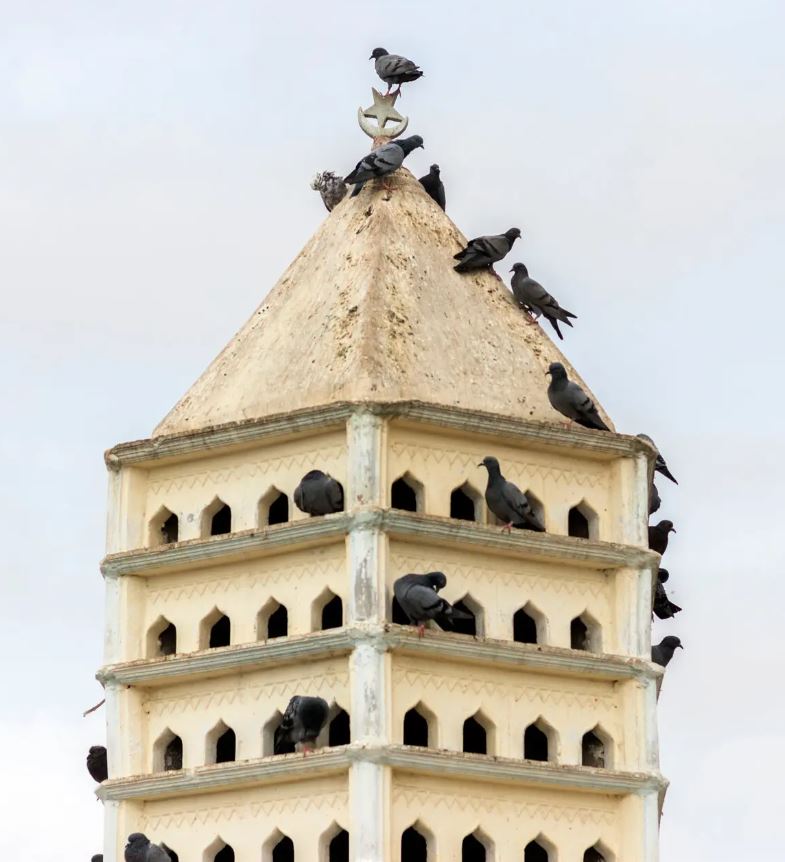A number of years ago, when I was visiting Bhuj, a little city located in Gujarat, India’s westernmost state, I came upon a magnificent and at first puzzling building. It was a column that supported an enclosure that was embellished with hundreds of holes. My first thought was that it was a geometric abstraction of a huge tree, but then I saw a pigeon peeking out from one of the gaps in the structure.
As time went on, there were soon hundreds of birds entering and exiting the magnificent birdhouse. According to the information provided to me by the locals, the building is known as a “chabutra.”
I began documenting the beautifully crafted birdhouses during the course of my initial four-month stay, as well as during subsequent visits throughout Kutch, which is the district that includes Bhuj. This involved taking photographs, collecting local narratives, and recording people’s memories that were associated with the structures.
The antique bird towers that I came upon were constructed out of stone and wood. The most recent examples are almost always built of concrete and have a far greater range of colours and intensities. Each design is distinct.
Housing and providing food for birds is a typical activity over most of India. However, the communal affection for birds manifests itself in a variety of various ways depending on the city. Pigeon-rearing, also known as kabootar-baazi, is practised in certain communities. This activity requires taming the birds, looking after their health, teaching them to fly in a specific direction in response to vocal directions, and preparing them for flying contests. Others concentrate on the preservation of natural resources. Others manufacture chabutras for themselves.
Elegant birdhouses may be seen in the majority of the settlements and hamlets that are located within the Kutch area of Gujarat. Masons are often responsible for the design and construction of the buildings, despite the fact that they have not had any formal training in design. Nevertheless, they are able to convey the values that are important to the communities in which they work.
The homes are more than just a spot for the birds to rest their heads. They also serve the purpose of becoming community places. Elder men and women sit beneath their shade. Children may be heard playing nearby. Around them, celebrations are often staged throughout the year.
In light of the fact that, much like people, birds make use of a diverse range of dwellings, I find it easiest to refer to the structures as “bird housing” rather than “bird homes.” A few of the buildings are designed to resemble sarais or hotels, serving as a location for the animals to stay for a short time before continuing on their journey. The remainder are apartment complexes, some of which have as many as forty levels.
If we examine the chabutras from the point of view of architecture, we could be able to classify some of them as Indo-Saracenic, Brutalist, postmodern, or contemporary.
There is a possibility that the religious and cultural identities of a community are connected to chabutras in some way. Many individuals construct the buildings as monuments to friends and family members who have passed away, and they think that providing the constructions with food is analogous to providing sustenance to the spirits of the dead. There is a school of thought among certain Hindus that presenting food at the building is analogous to feeding god.
Therefore, it should not come as a surprise that significant contributions of birdseed are often offered during significant social occasions such as funerals, marriages, and births. In some communities, making a contribution of grain to the communal chabutra might even be considered a form of punishment or a requirement for doing community duty.
In the course of my research into and documentation of the chabutras located in Kutch, I have been to a large number of the region’s villages and engaged in conversation with a large number of the locals who assist in the stocking and maintenance of the structures. And although the ancient wooden birdhouses in certain locations, like Ahmedabad, which is Gujarat’s most populated city, have been thoroughly recorded, equal attention has not been devoted to those in Kutch. This is because Kutch is located in the southern part of the state.
My objective with this project, which I’ve been working on for the past seven years, has been to assist in making up for the lack of attention that has been paid to Kutch’s chabutras, particularly in the wake of a devastating earthquake that occurred in 2001 and caused the loss of many of the celebrated stone specimens.
The earthquake was responsible for the destruction of numerous old chabutras; yet, it was also instrumental in the development of new buildings, which are visible today.

